Oh, I don’t even know where to begin this one…. Hmmm, let’s start with last day in Trujillo before heading to the mountaintop to visit Henry’s dad. We had lunch at Coquito’s, a popular seafood place in the northeast of the city:
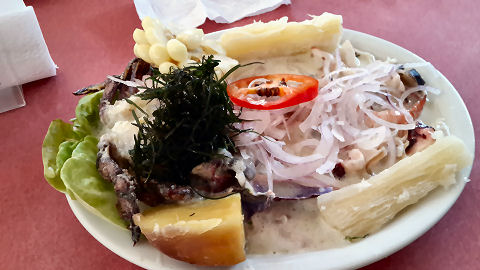
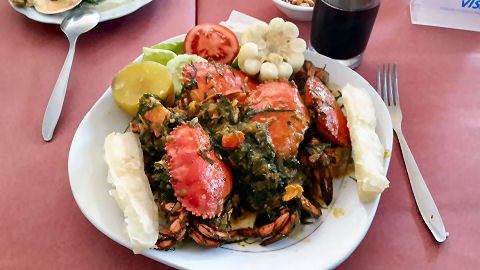
Henry and I invited out three of his sisters for lunch and we made our way through quite good plates of different ceviches, stir-fried rice with seafood, a couple of different fish soups, and one of my favorites, crab “reventado”. Very reasonably priced and well worth seeking out if you’re in Trujillo.
It was packing and early to bed as we had to be up at 3 a.m. for the 6 hour trip up into the mountains. Promptly at 3 Henry’s nephew Alan pounded on the door to say he was waiting – we were just waking up, so it took the gang of four of us about 20 minutes to get up, dressed, and into the car. We joined up with a caravan of two others being driven by another newphew and a brother-in-law and headed out of town. I’ve tried to follow the route on Google Earth to point out where we went, but I keep losing the dirt road as it winds around – I know approximately where Calamarca is according to its official latitude and longitude, but when I put in the coordinates, there’s no town showing in the picture – I’ve kind of shifted around the area looking, but I don’t see it. Let’s just say it’s 2 hours on a paved highway to Otuzco from Trujillo, then 2 hours on a semi-paved road heading somewhat southeast, and then 2 hours on gravel that winds through the mountains like a tangle of spaghetti – and Henry’s nephews drive like maniacs, playing chicken with each other on the road, driving without their lights, trying to run each other off the road, etc. – after a bit of that we all screamed at them to cut it out or we’d toss them from the cars. But, stressed out, we made it to Calamarca somewhere around 9 in the morning.
![[Photo from Henry of the whole town]](https://www.saltshaker.net/wp-content/uploads/2013/07/calamarca00-e1418302417784.jpg)
So I, one of his sisters and her daughter spent Friday until Sunday afternoon there, the main purpose that we all headed up here was it was the 23rd anniversary of the founding of the town and there were parades and music and fireworks to be had. Ostensibly. My 2 plus days were about as much of the place as I could take, I have to admit. I understand the family’s nostalgia for where many of them grew up, but it should be noted that most of them never go back – Henry usually does once a year to see his father, but, for example, one of his sisters hadn’t been there in 16 years – and there’s some reason for that. The remainder of the family who came up stayed on for a few days more.
There’s good and there’s bad. The good – it’s beautiful scenery, truly gorgeous. The air is crisp and clean when you’re out walking in the fields and on the mountainside. At night you can see more stars than you could imagine. Henry’s family up there is as friendly as the family in Trujillo and warmly accepted me (albeit I was touted as “a friend and business associate” to dad and the elder aunts – though I’m pretty sure dad figured it out, just based on a few things he said to me in passing conversation).
But, the bad – now, partially it’s due to it having been a festival weekend (which happens twice a year in town) – everyone is not on their best behavior, and the men have a tendency to drink to excess – the standard practice is a group of 5-6 grab a few cases of liters of beer and proceed to drink all of it in a round robin fashion – shared glass, each person pours a half glass, passes the bottle to the next in the circle, downs their glass, shakes it out, passes it on to the bottle holder, and it continues, all day long – the first day, his brother-in-law, by our estimate, went through 8 cases of beer (12 liters each) with four friends – they were all near unconscious by bedtime. But that’s apparently just a fiesta thing, the rest of the time the townfolk are too busy working and don’t have the money to spend on beer – they save up for the two fiestas. There’s no real running water – there’s a pipe that comes down from the mountain with run-off spring water – but it’s sporadic. Same with electricity – most of the weekend we didn’t have any – it comes and goes. There are no bathroom facilities. Really. A couple of people in town have outhouses, but only a couple out of a couple of hundred homes. The standard approach for #1 is to just whip it out if you’re a guy, or squat down if you’re a gal, wherever you happen to be – in the street, at the side of a house, wherever. #2 is a bit worse – during the day folk tend to simply take a short hike out of town carrying a roll of paper and into a nearby field and go about their business. At night, however, no one wants to make the effort and so the #1 approach is used. And, of course, the animals that people have, be they the standard mode of transit of either a horse or burro, or someone’s cows, sheep or goats, do what they do naturally, wherever they feel like. That’s a little tough to grasp, you know? Basically, the whole town smelled of beer, piss, crap, and dirt. Oh, and at night, it’s cold, really cold, and there’s no heat unless you burn something. And the air is 0% humidity dry, and at around 10,000 foot altitude, so it’s also low in oxygen. Needless to say, I was ready to leave pretty quickly.
Let’s go to the pix:
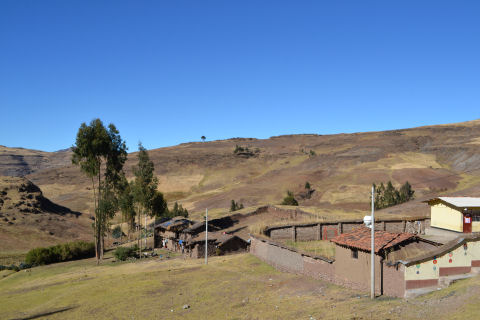
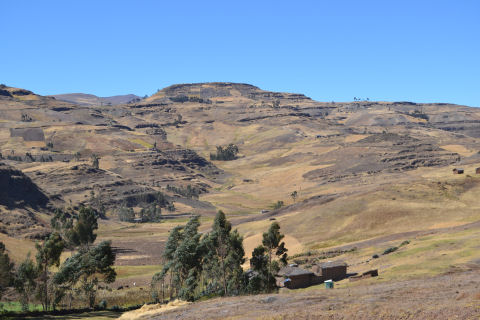
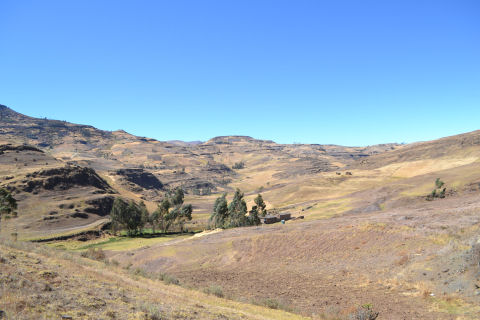
Told you it was beautiful countryside.
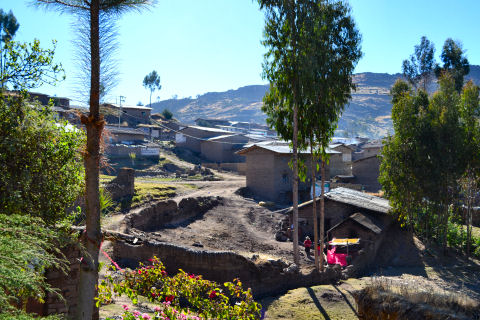
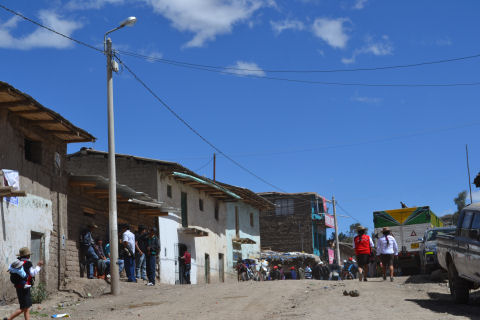
The town is less attractive, consisting of a couple of hundred basic structures with dried mud brick walls, dirt floors, and either tin or thatch roofs.
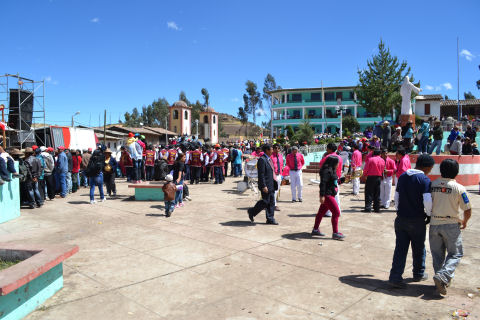
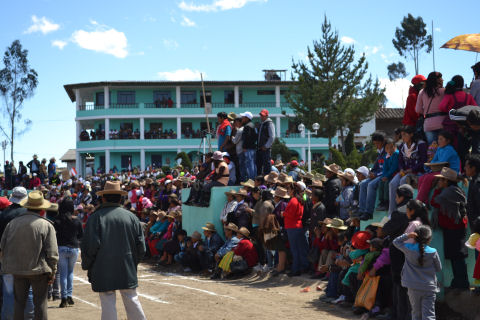
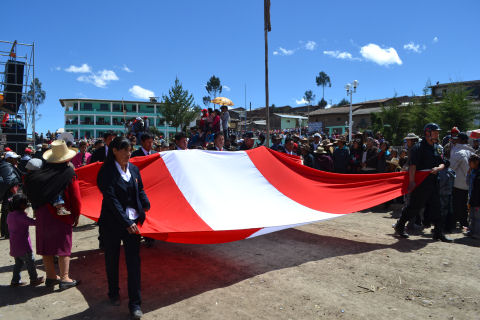
The central Plaza de Armas where most of the festival took place. Except the soccer matches and the bullfights (the first time I’ve ever seen one, and I never want to again, it’s a disgusting, barbaric practice that should be banned – actually, it is in most countries). This was the first time they’d ever held one in Calamarca and they brought in bullfighters from other parts of the country. At the end though, you could tell people had really mixed feelings about it, so hopefully it won’t be repeated.
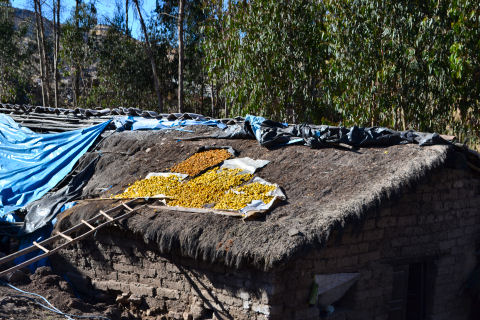
Drying potatoes in the sun, to later be milled into a coarse meal that’s used in soups by almost everyone.
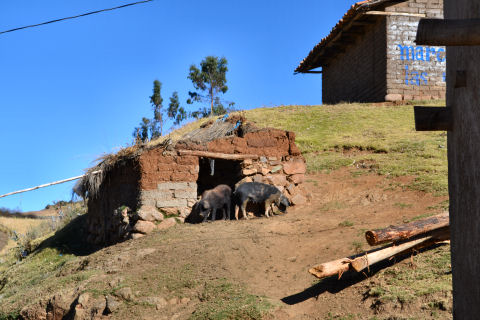
Henry’s aunt keeps a couple of pigs in the back. We ate most of our meals at her house – a fair number of soups and stews, all potato based, either fresh or dried. One non-soup plate over the three days, a bit of stewed chicken with boiled fresh green wheat kernels. A bit much starch for my tastes, and particularly potatoes, but it’s nourishing and filling for the folk who live and work there.
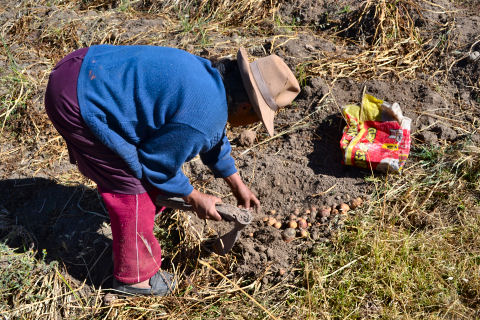
And the family has their own potato fields, which is new for them – they actually own some 36 hectares of farmland, and in his dad’s younger days they were all planted with different crops and they raised cattle and sheep. But as dad got older he wasn’t able to run things and no one else in the family picked up the slack, so the fields have been left to pasture for years – and they just rented out the grazing rights to neighbors. But Henry has started investing in the seeding of the fields, a bit at a time, and his aunts and cousins now have fields that are being put to better use – this is the new yellow potato field, harvesting has just started (Henry actually stayed behind to help with the harvest this week).
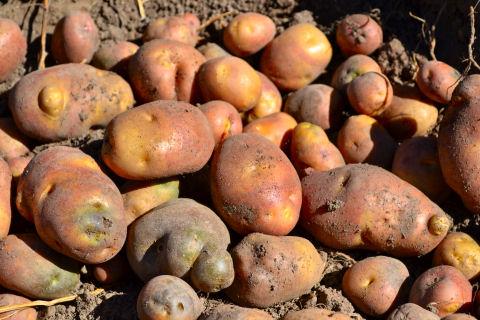
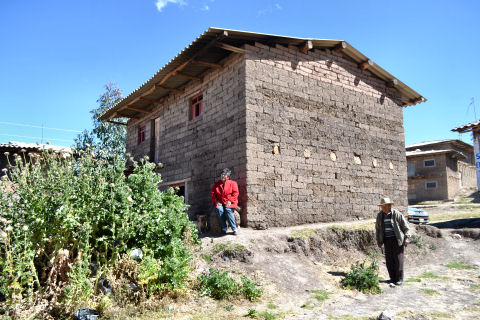
There used to be two houses here, this one is his dad’s, to the left was the second house that was basically run by his mom when she was alive, and in which he grew up in his early years. No one kept it up and sometime over the last year it collapsed – it was fairly emotional for him as he didn’t know it had until he saw it. Now he wants to rebuild it, but out of something other than the standard dried mud bricks that most of the town is constructed of. But the fields come first, as his dad doesn’t really need a second house – I think he’d be better off investing in upgrading the existing one.
Back to Trujillo by bus as one of the cars broke down and only three of us were leaving. The bus is almost as bad, but at least it was daylight and the driver, while a bit of a speed demon, wasn’t completely crazy. Spent the night, then flew to Lima for a day and a half, where I am now. In the morning, off to La Paz, Bolivia.
I always especially enjoy your posts when you visit Perú. From the first one, which included the Jirón de la Union – where we used to don gloves to go shopping, followed by tea in the Hotel Bolivar – to this last one about visiting a small town in the altiplano.
I visited many of those small towns in my youth and can identify with the descriptions of the views, smells and food. I could probably describe the inside of the houses still. Wonderful places to visit for a couple of days, a relief to return to indoor plumbing after you leave. I don’t think it was really 10,000 meters up in the mountains but understand the feeling!
Kudos to Henry for always connecting to his roots and trying to help his family. He must be such an interesting person to be able to function in both Calamarca and Buenos Aires. Talk about contrasts.
Looking forward to Bolivia!
He does seem to be able to adapt wherever we go – then again I do too, generally – I think it’s part of why we make a good couple!
10,000 feet – not meters… in meters I think I remember reading 3140, so it’s actually around 10,300 feet.
Wow! I thought that I’d visited and lived in some out of the way places. It was very good of you to accompany Henry to see his father here. Given the conditions, brave, even. I agree with you about bull fights. Totally barbaric and needless. La Paz must seem like Manhattan after this.